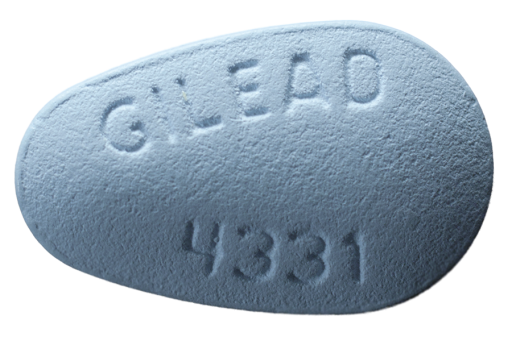Viread
tenofovir disoproxil fumarate (TDF)

Standard Dose
For adults, one tablet once per day, with or without food. Also available as an oral powder and as smaller pediatric tablets for children aged 2 years and older weighing at least 22 pounds (10 kg).Take your missed dose as soon as possible unless it is less than 12 hours until your next dose. Never double your dose. Viread should be avoided in individuals with existing chronic kidney disease, but if use cannot be avoided, dose adjustments are needed (SEE chart below).
Manufacturer
Gilead SciencesAWP
Viread300 mg tablets: $1,504 / month
250 mg, 200 mg and 150 mg pediatric tablets: $1,394 / week
40 mg/g powder (pediatric): $820–$3,076 / month based on dose required
Generic
300 mg tablets: $110–1,216 / month
Potential Side Effects and Toxicity
Viread is a well-tolerated with minimal side effects. Side effects may include diarrhea, nausea, weakness, headache, depression, abdominal pain, rash, excessive gas, and generalized pain and achiness. Nervous system side effects include depression, insomnia, peripheral neuropathy and dizziness. Viread may lead to decreases in bone mineral density (BMD); patients should be monitored for osteoporosis or osteopenia. Viread is processed by the kidneys so there is risk of kidney toxicity, including acute renal failure. Before starting treatment, patients should have their creatinine clearance (CrCl) assessed. Routine monitoring of glucose and protein in the urine and of serum phosphorus should be standard of care, too. If you experience any pain in the extremities, persistent or worsening bone achiness/pain or fractures with or without muscular pain, consult your medical provider immediately. Viread may lead to lactic acidosis; its use may lead to lactic acid in the blood, which could be fatal. Signs and symptoms of lactic acidosis include feeling very weak or excessively fatigued, difficulty breathing, stomach pain with nausea and vomiting, feeling cold and chills (especially in arms and legs), dizziness and light-headedness, fast or irregular heartbeat, or unusual muscle pain. If you experience any of these symptoms contact your medical provider immediately. Enlarged liver or fatty liver may occur. Signs and symptoms include yellowing of the eyes and/or skin (jaundice), dark colored urine, light colored stools, nausea, loss of appetite, and pain, achiness or tenderness of the liver (lower right side of the belly, below the ribcage and next to the belly button).
Potential Drug Interactions
Be sure to tell your medical provider or pharmacist about all the medications, supplements, and herbs you take, whether they are prescribed, over-the-counter, or recreational, before starting this regimen. Report any changes to your medications as they happen. Do not take Viread with the HBV treatment Hepsera. Because Viread is related to Vemlidy, the two medications cannot be taken together. Similarly, Viread cannot be taken with any of the following HIV combination medications: Atripla, Biktarvy, Cimduo, Complera, Delstrigo, Descovy, Genvoya, Odefsey, Stribild, Symfi, Symfi Lo, Symtuza, Temixys or Truvada. Viread reduces the level of Reyataz, meaning that Reyataz 300 mg must be boosted with Norvir 100 mg or Tybost 150 mg (taken with food) when used together. Kaletra, boosted Prezista and boosted Reyataz increase Viread levels but do not require dose adjustments. This interaction may increase Viread-related side effects; routine monitoring is recommended. Viread should be avoided with any medications that could negatively affect the kidneys, including chronic use or high doses of NSAIDS (non-steroidal anti-inflammatory drugs, such as Advil, Aleve, ibuprofen, naproxen or Motrin).
More Information
Viread will not cure HBV—currently, no HBV medication will cure you—but it can decrease your risk of long-term complications such as cirrhosis or liver cancer. Viread is related to Vemlidy. Viread and Vemlidy are also HIV medications. Before starting Viread, you should be tested for HIV. If you are coinfected with HBV/HIV, you should not treat HBV without also treating your HIV to prevent the development of HIV resistance mutations in the HIV. In people with HBV/HIV coinfection, the combination of Emtriva and Vemlidy (or Viread) is the preferred regimen for treatment of HBV. If you have HBV/HIV and need to switch from any tenofovir-containing regimen—such as Vemlidy—there is a risk of an HBV flare-up with signs and symptoms of acute HBV infection. Abrupt discontinuation of Vemlidy may cause a severe, acute exacerbation of hepatitis B, which can result in hepatic decompensation and liver failure. If Vemlidy is discontinued, your doctor should closely monitor you for symptoms of exacerbation. Do not stop this medication without talking to your doctor first. SEE HBV Reactivation for more information and consult your medical provider. For individuals with HBV/HCV coinfection, or who are at risk of HBV reactivation while undergoing HCV DAA treatment, Viread is one of the medications you could be prescribed to prevent this from happening. Viread is safe to take with HCV DAAs, but you should be monitored for side effects if it is used with Epclusa, Harvoni or Vosevi and a boosted regimen for treatment of HIV.
Viread does not require dose adjustment for hepatic (liver) impairment.



